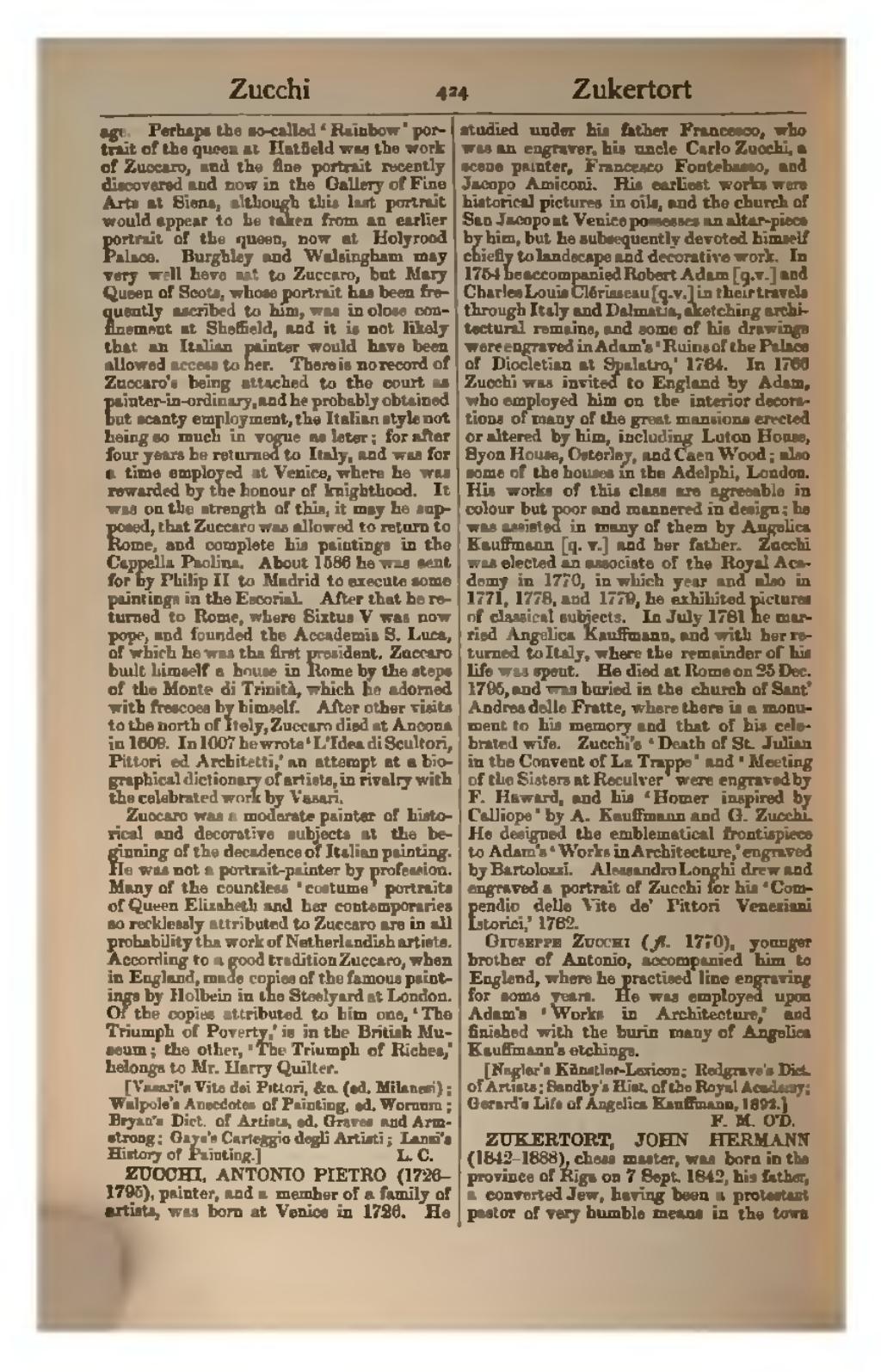age. Perhaps the so-called ‘Rainbow’ portrait of the queen at Hatfield was the work of Zuccaro, and the fine portrait recently discovered and now in the Gallery of Fine Arts at Siena, although this last portrait would appear to be taken from an earlier portrait of the queen, now at Holyrood Palace. Burghley and Walsingham may very well have sat to Zuccaro, but Mary Queen of Scots, whose portrait has been frequently ascribed to him, was in close confinement at Sheffield, and it is not likely that an Italian painter would have been allowed access to her. There is no record of Zuccaro's being attached to the court as painter-in-ordinary, and he probably obtained but scanty employment, the Italian style not being so much in vogue as later; for after four years he returned to Italy, and was for a time employed at Venice, where he was rewarded by the honour of knighthood. It was on the strength of this, it may be supposed, that Zuccaro was allowed to return to Rome, and complete his paintings in the Cappella Paolina. About 1586 he was sent for by Philip II to Madrid to execute some paintings in the Escorial. After that he returned to Rome, where Sixtus V was now pope, and founded the Accademia S. Luca, of which he was the first president. Zuccaro built himself a house in Rome by the steps of the Monte di Trinità, which he adorned with frescoes by himself. After other visits to the north of Italy, Zuccaro died at Ancona in 1609. In 1607 he wrote ‘L'Idea di Scultori, Pittori ed Architetti,’ an attempt at a biographical dictionary of artists, in rivalry with the celebrated work by Vasari.
Zuccaro was a moderate painter of historical and decorative subjects at the beginning of the decadence of Italian painting. He was not a portrait-painter by profession. Many of the countless ‘costume’ portraits of Queen Elizabeth and her contemporaries so recklessly attributed to Zuccaro are in all probability the work of Netherlandish artists. According to a good tradition Zuccaro, when in England, made copies of the famous paintings by Holbein in the Steelyard at London. Of the copies attributed to him one, ‘The Triumph of Poverty,’ is in the British Museum; the other, ‘The Triumph of Riches,’ belongs to Mr. Harry Quilter.
[Vasari's Vite dei Pittori, &c. (ed. Milanesi); Walpole's Anecdotes of Painting, ed. Wornum; Bryan's Dict. of Artists, ed. Graves and Armstrong; Gaye's Carteggio degli Artisti; Lanzi's History of Painting.]
ZUCCHI, ANTONIO PIETRO (1726–1795), painter, and a member of a family of artists, was born at Venice in 1726. He studied under his father Francesco, who was an engraver, his uncle Carlo Zucchi, a scene painter, Francesco Fontebasso, and Jacopo Amiconi. His earliest works were historical pictures in oils, and the church of San Jacopo at Venice possesses an altar-piece by him, but he subsequently devoted himself chiefly to landscape and decorative work. In 1754 he accompanied Robert Adam [q. v.] and Charles Louis Clérisseau [q. v.] in their travels through Italy and Dalmatia, sketching architectural remains, and some of his drawings were engraved in Adam's ‘Ruins of the Palace of Diocletian at Spalatro,’ 1764. In 1766 Zucchi was invited to England by Adam, who employed him on the interior decorations of many of the great mansions erected or altered by him, including Luton House, Syon House, Osterley, and Caen Wood; also some of the houses in the Adelphi, London. His works of this class are agreeable in colour but poor and mannered in design; he was assisted in many of them by Angelica Kauffmann [q. v.] and her father. Zucchi was elected an associate of the Royal Academy in 1770, in which year and also in 1771, 1778, and 1779, he exhibited pictures of classical subjects. In July 1781 he married Angelica Kauffmann, and with her returned to Italy, where the remainder of his life was spent. He died at Rome on 25 Dec. 1795, and was buried in the church of Sant' Andrea delle Fratte, where there is a monument to his memory and that of his celebrated wife. Zucchi's ‘Death of St. Julian in the Convent of La Trappe’ and ‘Meeting of the Sisters at Reculver’ (from Keate's ‘Sketches from Nature’) were engraved by F. Haward, and his ‘Homer inspired by Calliope’ by A. Kauffmann and G. Zucchi. He designed the emblematical frontispiece to Adam's ‘Works in Architecture,’ engraved by Bartolozzi. Alessandro Longhi drew and engraved a portrait of Zucchi for his ‘Compendio delle Vite de' Pittori Veneziani Istorici,’ 1762.
Giuseppe Zucchi (fl. 1770), younger brother of Antonio, accompanied him to England, where he practised line engraving for some years. He was employed upon Adam's ‘Works in Architecture,’ and finished with the burin many of Angelica Kauffmann's etchings.
[Nagler's Künstler-Lexicon; Redgrave's Dict. of Artists; Sandby's Hist. of the Royal Academy; Gerard's Life of Angelica Kauffmann, 1892.]
ZUKERTORT, JOHN HERMANN (1842–1888), chess master, was born in the province of Riga on 7 Sept. 1842, his father, a converted Jew, having been a protestant pastor of very humble means in the town
